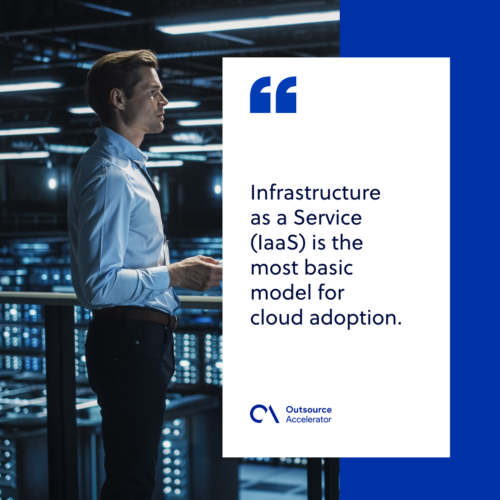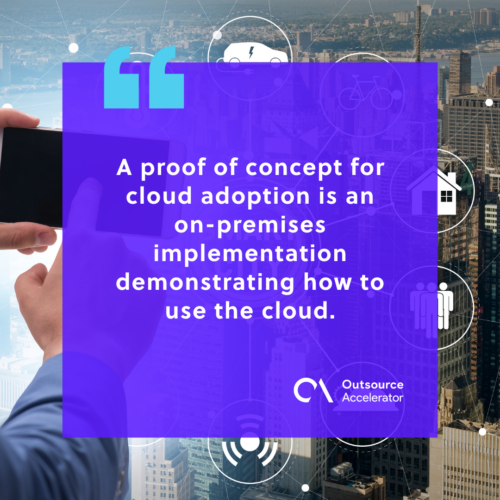Step-by-step guide: Implementing cloud adoption for your business

Cloud adoption moves business applications to the cloud, whether it means moving an existing application or creating a new one. The term refers to using cloud technology as a platform for computing activities by businesses, governments, and other entities.
Cloud adoption enables companies to quickly scale up or down their resources while providing low-cost storage, computing power, and software as a service (SaaS).
The cloud has become increasingly popular within the past decade, with many businesses opting for this model over on-premises solutions. This shift has led to significant growth in the industry as a whole, which is expected to reach $2.32 billion by 2032, according to Market.Us.
Cloud adoption services
There are three primary models to choose from when implementing cloud adoption:
Infrastructure as a Service (IaaS)
Infrastructure as a Service (IaaS) is the most basic model for cloud adoption. The cloud provides raw computing power, storage, and network resources.
Customers can use these resources to create virtual machines or containers. The IaaS model is flexible and scalable, meaning users can adjust their usage of resources at any time.
The infrastructure in question is the cloud’s virtualized environments. The cloud provider manages everything from security to maintenance and upgrades, allowing you to focus on business instead of worrying about IT infrastructure.

Platform as a Service (PaaS)
The Platform as a Service (PaaS) cloud adoption model provides a platform, or runtime environment, for application developers.
Platforms give pre-built databases, application programming interfaces (APIs) for accessing data sources, and tools to run applications. IaaS, in contrast, deploys applications on the same hardware as the operating system.
PaaS is still relatively new, however. It may present challenges when navigating the various providers and understanding how they differ from one another.
Still, PaaS offers more flexibility than traditional software deployment because it allows developers to work with multiple programming languages, databases, and tools.
Software as a Service (SaaS)
Software as a Service (SaaS) is a business and cloud adoption model in which software is licensed on a subscription basis and is centrally hosted. It’s more scalable, easy to use, and costs less than traditional common license software.
SaaS distributes software applications and platforms to consumers and businesses across the Internet. It includes web-based platforms, mobile apps, desktop apps, and back-office business software.
The cloud vendor provides everything needed for operations, including running the servers, storing data, and delivering content.
How to implement cloud adoption
Cloud adoption is a journey and not simply something done in one step.
Below are some of the key steps that you should know when implementing cloud adoption.
Assessment
Before starting cloud adoption, assessing your current state of affairs and what needs to be done to achieve your goals is essential.
This assessment should include:
- A review of existing systems and applications
- A review of data storage needs (including possible future needs) and regulatory compliance requirements
- A review of application performance, including latency and uptime
Proof of concept
A proof of concept can relieve the fears that companies have of using “new and untested” cloud technology. It can also help you better understand how the cloud works and how it might fit into your business processes.
A proof of concept for cloud adoption is an on-premises implementation demonstrating how to use the cloud. It’s relatively safe because it doesn’t yet move any of your data or applications.

Data and application migration
A key step in cloud adoption is moving your data and applications from one environment to another. Data can be transferred either manually or automatically, depending on its size and volume.
Once data has been moved over to the cloud, you’ll need a way to access it so that applications can be used remotely via the network. Cloud providers also offer application hosting services to achieve this.
Leveraging the cloud
This stage of cloud adoption gives you access to the tools that the cloud framework offers. You’ll be able to scale your functions automatically to maximize the benefit to the organization.
Optimization
Finally, you can tune and optimize the system to get the most out of your cloud adoption model. You can make optimal use of available resources, monitor performance to detect anomalies early, and adjust where the transition isn’t working properly.
Business benefits of cloud adoption
There are multiple benefits that businesses have found by moving their operations to the cloud. Take a look at some of the advantages you’ll see from cloud adoption:
Better customer service
Cloud technology makes it easier for businesses to provide better customer service in real-time by allowing employees to work remotely. This enables them to respond quickly to customer questions or concerns about products or services.
Cloud computing can also help businesses deliver better customer service. Cloud adoption enables them to handle exceptions better, implement new features more quickly, and provide personalized experiences for their customers.
Cost efficiency
Cost savings is a big benefit of using cloud services. Cloud providers only charge based on usage, so there’s no need to buy expensive hardware or software upfront.
In addition, the cloud can spread out costs over multiple clients that use their services. This means they charge less per user than if they were selling directly to each customer.
Improved security
Security has become a key concern as internet-based services grow, with Check Point Research reporting a 38% rise in global cyberattacks for 2022.
Cloud adoption gives you some added security advantages, such as providing users their virtualized space to store data separately. The fact that cloud services are hosted off-site also means there is less chance of an attack on your network infrastructure.

Increased collaboration
Cloud adoption has made it easier for organizations to collaborate with partners and employees worldwide. The ability to share resources across multiple locations and platforms has helped improve productivity levels.
This reduces time spent on projects and enables faster decision-making.
Innovation and agility
With increased collaboration comes the development of new ideas and ways of doing business that previously wasn’t possible.
Cloud adoption also encourages agility. You’re not locked into one way of using the technology and can respond quickly to business needs.
Promotes scalability and elasticity
Cloud adoption allows IT teams to scale their systems based on actual demand. There’s no need to buy excess capacity they might not need. This provides businesses with greater flexibility when expanding their operations.
Streamlined IT operations
Cloud adoption shifts your focus away from managing hardware and software to adding value for your customers. IT staff can concentrate on more strategic initiatives that will benefit the company as a whole.







 Independent
Independent




